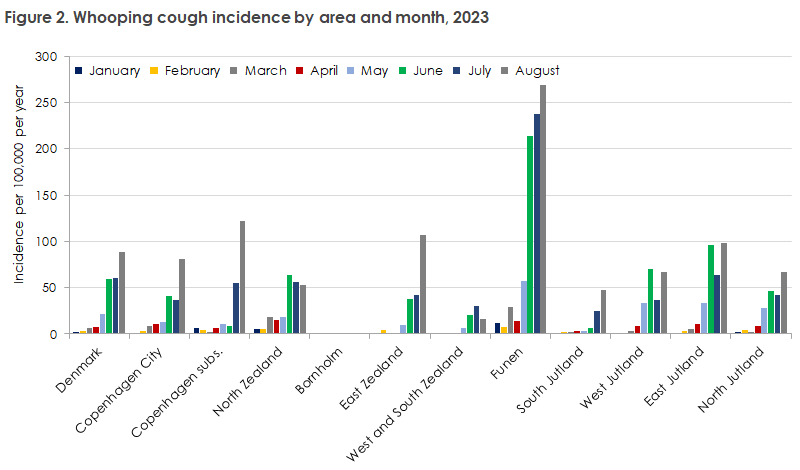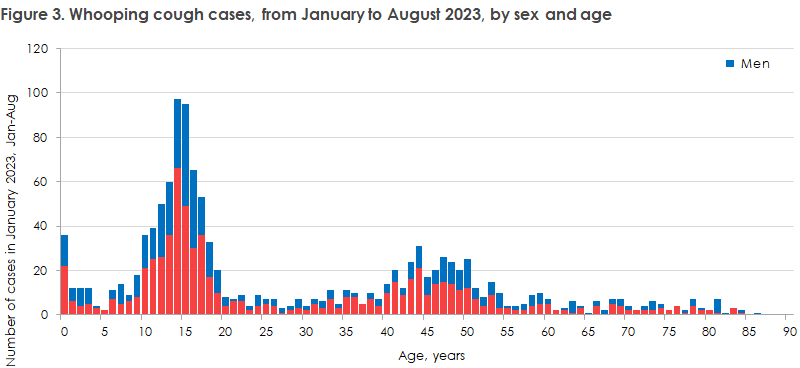No 36 - 2023
Epidemic occurrence of whooping cough
Epidemic occurrence of whooping cough
In early July, the SSI informed of an increase in the occurrence of whooping cough, EPI-NEWS 27/2023. The increase has continued throughout the summer, and the number of whooping cough cases in August reached a total of 439. This is approx. four times higher than normal between epidemics. The increase was recorded in nearly all Danish areas, and the SSI therefore assesses that we are experiencing an epidemic. This statement is based on data from laboratories in Denmark that perform analyses to detect whooping cough. Individuals with whooping cough without a verification from a laboratory are therefore not included.
Whooping cough occurs cyclically with epidemics approx. every 3-5 years. This pattern is also observed in other countries with a similar high vaccination coverage as Denmark. The two latest epidemics occurred in 2019-20 and in 2016-17, EPI-NEWS no. 39/2019 and 46/2016.
Figure 1 presents the monthly occurrence of laboratory-detected whooping cough from January 2015 through August 2023. The highest occurrence recorded during the 2016-17 epidemic was 289 cases per month, and the highest occurrence during the 2019-20 epidemic was 875 cases per month. In the years characterised by COVID-19 lock-downs, the occurrence was unusually low.

Figure 2 presents the incidence of detected whooping cough for all of Denmark and for each of the eleven areas, with respect to residence. The months of June, July and August have recorded a considerable increase in all areas, barring the island of Bornholm, where no whooping cough cases have been detected to this date in 2023.

Table 1 presents the number of detected whooping cough cases by month and residence area in 2023. A total of 1,229 cases of whooping cough have so far been detected in 2023. A considerable increase is observed from 12 detected cases in January to 439 cases in August. The increase is observed for all areas apart from Bornholm.

Whooping cough occurs in all age groups, but a preponderance is typically observed among infants, larger children and adolescents. Furthermore, the occurrence is often higher among adults aged 40-50 years, most likely because parents to children with whooping cough are also tested. A female preponderance is seen as 58% of all cases were women.
Figure 2 presents the distribution by age and sex for whooping cough cases detected in Denmark from January to August, 2023. A particularly high occurrence is seen among infants aged 0 years, larger children aged 9-19 years and among adults aged 40-50 years.

Whooping cough in children below two years of age is notifiable; and in 2023, a total of 48 cases have currently been notified in this age group. Table 2 presents the distribution of these children by age and vaccination status.

Whooping cough vaccination forms part of the Danish vaccination programme (3-5-12 months and 5 years), but vaccination does not provide life-long protection. Whooping cough occurs in all age groups, but the vaccination programme primarily aims to protect infants against the disease as infants are at risk of experiencing a serious course of the disease. Doctors should therefore remain particularly attentive to transmission to infants; notably to unvaccinated or partly vaccinated children below six months of age.
Based on the increasing occurrence, a temporary whooping cough vaccination offer for pregnant women was re-introduced as per 1 August 2023, EPI-NEWS 32-33/2023. Pregnant women are recommended to receive a whooping cough vaccination in their second or third trimester. This provides the infant with a protection lasting until the child can receive its first vaccination at three months of age.
Based on the number of women who at some point in 2023 until the end of June have seen their general practitioner for the first pregnancy examination, a minimum of 4,625 pregnant women received whooping cough vaccination in August alone.
For more information about the condition and guidelines on whooping cough diagnosis, please see the Disease Encyclopaedia at the SSI website (in Danish). Also see guidelines on post-exposure prevention (PEP) here.
(T. Dalby, P.H. Andersen, Department of Infectious Disease Epidemiology and Prevention)
6 September 2023